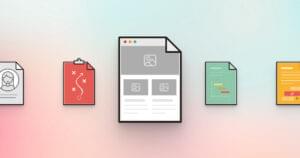Content Research: The Power of User Interviews
Key Takeaways
- User interviews provide valuable qualitative, scenario-style information about how users interact with a product or content. They offer unique insights into the user’s personality and their feelings towards the product, which cannot be easily tracked through analytics.
- Conducting user interviews requires careful planning and execution. It’s important to make the subject feel comfortable and at ease to encourage open and honest responses. The data gathered should be written up and reviewed to consolidate the insights gained.
- The main limitations of user interviews are that they provide qualitative information and can be time-consuming. It’s important not to make sweeping changes based on a single interview and to keep the insights in perspective.
- Insights from user interviews can guide various aspects of content creation such as topic selection, content format, tone and style, and content promotion strategies. They can help in creating content that resonates with the target audience and meets their needs and preferences.
(or How to Find Out What Makes Your Users Happy)
If you’re in UX – or you have been – you may already be familiar with the idea of doing user interviews to find out about the user experience.
But using interviews to research content? How does that work?
Last time I mentioned that we’d received some unexpected survey responses through both our open-ended question and spontaneous responses to our CTA email. A lot of those responses touched on an idea that I was barely conscious of: users who were struggling with our product asked others for help with it.

Again, this is something that can’t be tracked using analytics or on-site means. The survey responses showed that individuals asked their colleagues for help with the software. But I had no idea who those colleagues were. Were they:
- the person at the next desk?
- an administrator of our product?
- anyone who was more experienced?
I also wanted a clear view of the overall picture of ways users “solved problems” they experienced with our product. I work on the support site, but we also have account managers, a support helpdesk, and in-house administrators making up the “help” puzzle.
I needed to talk to real people.
What are interviews? What do they give you?
Interviews involve speaking to people — either in person or over the phone. I have a loose set of questions which really act as openers for lines of discussion. They cover the main questions I have about what the big “software support” picture is for our product, and how our content fits into that.
What we’re getting from our interviews is qualitative, scenario-style information about the kinds of things users do when they have a problem with the software.
In-person interviews (even over the phone) give you something unique: a sense of the personality of the user, and valuable auditory feedback. If I ask a user if they’ve ever used the support site, the speed and tone of their response gives cues as to whether they use it, whether they use it often, and how they might feel about it. Do they enter with confidence or dread?
Those cues can lead me to ask extra questions, digging deeper into issues that are sensed rather than implicitly spoken. Issues that are almost always invisible in the raw data.
How do interviews work?

I drafted a rough script in an attempt to touch on the main knowledge gaps I knew I had, and spoke to a friend whose company uses our software. She put me onto a colleague, who I called.
Even though she’d told him I’d call, I didn’t call and expect to interview him. I called to break the ice and explain what I was doing in a way that was intended not to bias his expectations (I didn’t tell him I worked on the support site, for example). We made a time for a 15-minute interview a couple of days later, and at that time I called back and interviewed over the phone, taking notes as I went.
This is a pretty rough-and-ready way to get started, but as I was formulating the idea of the interview, I wasn’t really sure where things were heading. You might argue that it would be ideal to speak to users face to face, and I wouldn’t disagree.
That would deliver information about the environments in which our users use the software, and how their workplaces operate. It could tell us, for example, if this particular user has a desk-buddy to ask for help, or if they’re in an office of their own. Do they use a chat app at work? If not, how far would they have to walk to ask someone to help with a problem on our system? In that case, would they be more likely to call our helpdesk instead? The questions just keep coming.
Even so, our little phone interview technique has delivered some great information about where our content fits into the scheme of things.
Interview wins
Who’s not winning in a user interview? As the researcher, you get a very strong sense of the kinds of people actually grappling with your product. As the user, you get the sense that the brand cares about you — you might even air a few grievances in the process, and (hopefully) feel like you’re being heard.
Our interviews helped us to realise that not only is our support site not users’ first port of call when they face a problem, but the entire suite of help offered by our company (from account managers to email and phone support) aren’t either.
When they struggle with the software, users, obviously, ask someone they work with about it.
We also learned that people designated as in-house administrators of our product at client companies do field plenty of questions from users — even though often, they may not know the answers at the time. The interviews flagged an opportunity to better support those administrators to support others in their companies.
Basically, the interviews are helping us to build a much richer understanding of the realities of support within the day to day context in which our product is used.
Interview limitations
The main limitation with interviews is that they give you qualitative information. You probably don’t want to rush off on the basis of a conversation with one user and make sweeping changes to your site. So it’s important to keep what you learn from each interview in perspective.
Another limitation is time. If your interview’s going to take what users perceive as “too long”, you might struggle to find subjects to talk with.
Remember too that on-site, face-to-face interviews are likely to be more of a burden to your subjects than phone interviews. And the more difficult you make the interview, the fewer subjects you’ll get.
Interview tips and tricks
Like surveys, which we looked at last week, interviews can seem easy enough to do at first glance. You work out what you want to know, and ask the subject the questions. Right?
Well, maybe. Look at any news or current affairs program and you’ll see that there are different interview styles, and good and bad interviewers. Anyone can ask questions, but there’s an art to a good interview.
The best tip I can give is to master that art as best you can, using resources like this article from UX mastery as a starting point. Sure, it’s about usability interviews, but that doesn’t mean it’s not relevant. You’re effectively researching how users use your content, so while some of the advice may not translate directly, it should give you the impetus to being to fill gaps yourself.
The other key to interviewing is to make the subject as comfortable as possible. Being interviewed is both flattering and nerve-wracking, so the more natural you can be with the subject, and the more at ease, the more open they’re likely to be with you. Make this your focus and you could wind up getting some real gems from your interviews.
Dealing with interview data

With the techniques we’ve looked at previously, click tracking and surveys, the data has been relatively easy to deal with, as it is at least largely quantitative. But what do you do with interviews?
I see the interviews as giving me information that helps shape my understanding of the way users use the content — that is, it provides a backdrop for the click tracking and survey information.
So the first thing to do is write them up after you’ve done the interview itself. This helps me to consolidate what I gleaned in the interview, and gives me a clearer picture of what that user was all about.
A good way to use your interview writeups may well be to distill them into the equivalent of user personas, where each one has a name, a role or business, and salient points that relate to how they use your content. You may not create content specifically for single user types (although you may).
But either way, the personas will remind you of the critical elements of your content’s use case, and you can make sure you consider each of those critical elements as you design, create, and present content on your site.
What’s next?
There’s one technique we haven’t looked at yet, though it’s a little like a survey: it’s user polling. Next time, we’ll turn our attention to user feedback and ratings widgets, and see what they add to the overall picture you have of how users consume your content — and what value it delivers.
But for now, let us know if you’ve done any user interviews. What are your tips and tricks for good user interviewing? We’d love to hear them in the comments.
Frequently Asked Questions (FAQs) about Content Research and User Interviews
What is the importance of user interviews in content research?
User interviews play a crucial role in content research as they provide direct insights from the target audience. They help in understanding the needs, preferences, and pain points of the users, which can guide the creation of more relevant and engaging content. User interviews can reveal trends and patterns that may not be apparent from quantitative data alone. They also allow for deeper exploration of user attitudes, behaviors, and experiences, providing a richer context for content development.
How can I effectively conduct user interviews for content research?
Conducting effective user interviews requires careful planning and execution. Start by defining your research objectives and identifying your target audience. Develop a set of open-ended questions that align with your research goals. During the interview, ensure to create a comfortable environment for the participants, listen actively, and avoid leading questions. After the interview, analyze the data systematically to draw meaningful insights.
What are some common mistakes to avoid in user interviews?
Some common mistakes to avoid in user interviews include asking leading or closed-ended questions, not properly recording the interviews, and failing to follow up on interesting points raised by the participants. Also, avoid making assumptions or judgments based on your own experiences or biases, as this can skew the results of the interview.
How can I recruit participants for user interviews?
You can recruit participants for user interviews through various methods such as social media outreach, email invitations, or using recruitment agencies. Ensure to select participants who represent your target audience in terms of demographics, behaviors, and attitudes.
How can I analyze the data from user interviews?
Analyzing data from user interviews involves transcribing the interviews, coding the data, identifying patterns and themes, and interpreting the findings in the context of your research objectives. You can use qualitative data analysis software to assist in this process.
How many user interviews should I conduct for content research?
The number of user interviews you should conduct depends on your research objectives and the complexity of the topic. However, a common rule of thumb in qualitative research is to continue conducting interviews until you reach ‘data saturation’, i.e., when no new themes or insights are emerging from the interviews.
Can user interviews be conducted remotely?
Yes, user interviews can be conducted remotely using video conferencing tools or telephone. Remote interviews can be a practical option when face-to-face interviews are not feasible due to geographical constraints or other reasons.
How can I ensure the reliability and validity of user interviews?
Ensuring the reliability and validity of user interviews involves careful planning, execution, and analysis. Use a consistent interview protocol, train the interviewers, and use multiple coders to analyze the data. Triangulate the findings with other data sources and seek feedback from the participants to validate the findings.
What are some ethical considerations in user interviews?
Ethical considerations in user interviews include obtaining informed consent from the participants, ensuring confidentiality and privacy, and treating the participants with respect and dignity. Also, be transparent about the purpose of the research and how the data will be used.
How can I use the insights from user interviews to improve my content?
Insights from user interviews can guide various aspects of content creation such as topic selection, content format, tone and style, and content promotion strategies. They can help in creating content that resonates with the target audience and meets their needs and preferences.
Georgina has more than fifteen years' experience writing and editing for web, print and voice. With a background in marketing and a passion for words, the time Georgina spent with companies like Sausage Software and sitepoint.com cemented her lasting interest in the media, persuasion, and communications culture.




